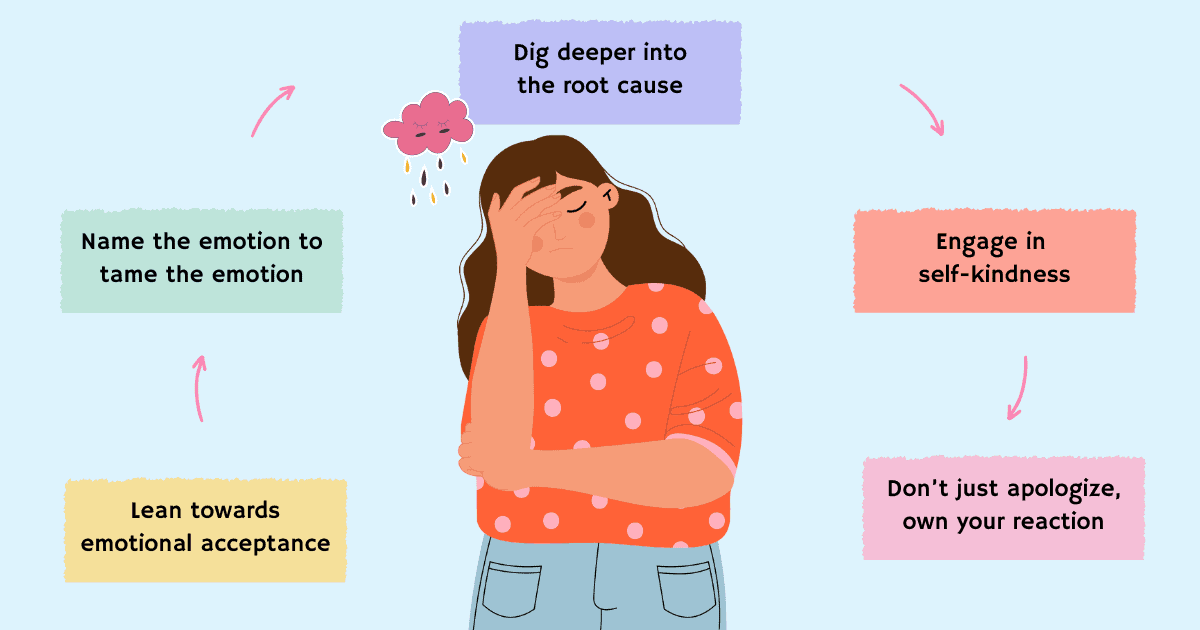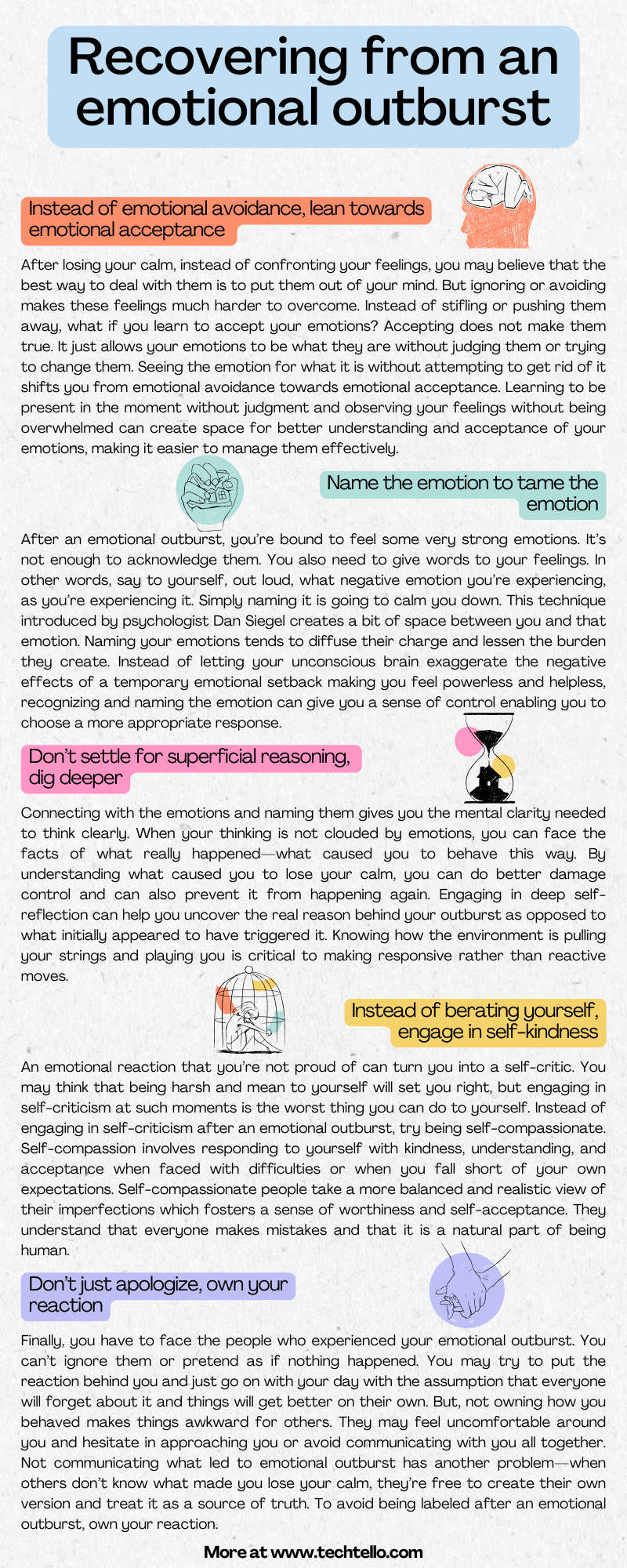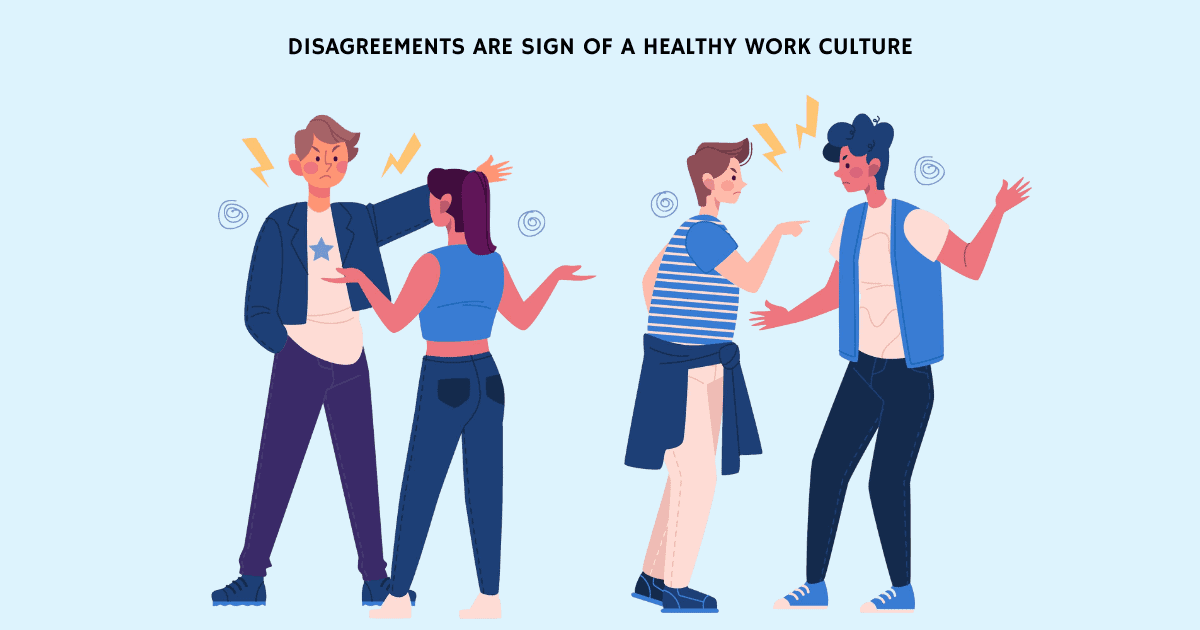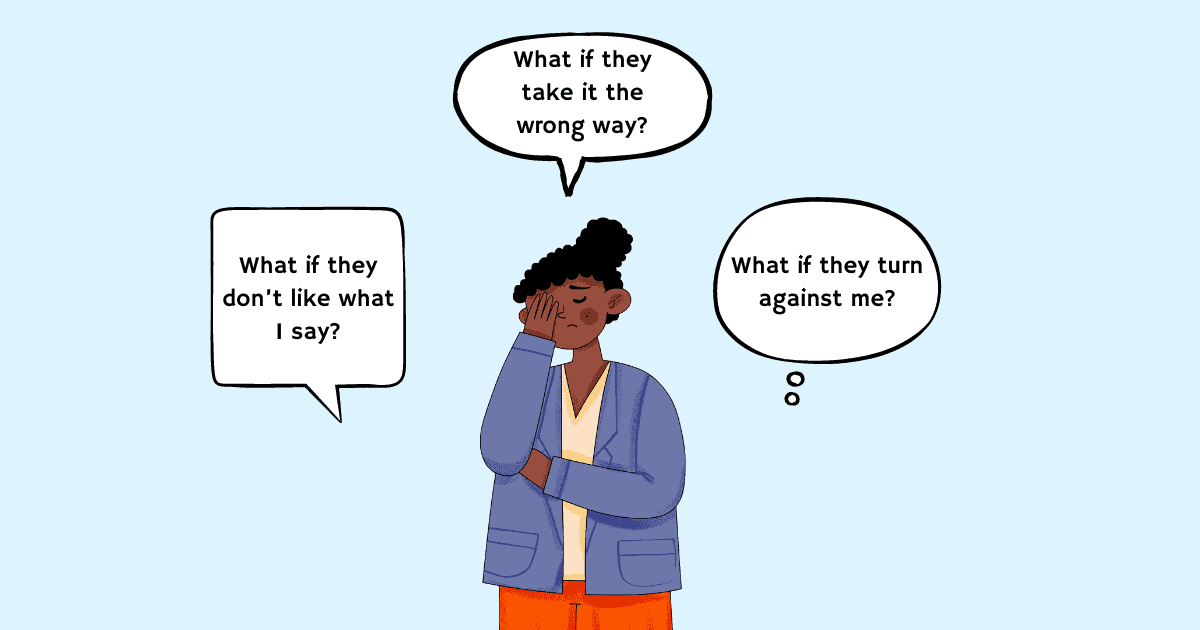Recovering From an Emotional Outburst At Work

Workplaces are filled with moments when it’s easy to lose your calm. Uncontrollable, sudden, and intense emotions that overwhelm you, can dramatically and unexpectedly lead to an emotional outburst.
Negative emotions like anger, fear or frustration show up when your expectations aren’t met or people say or do things that conflict with your personal values and aspirations. Ignoring the conflict or whatever’s bothering you for too long creates an inner turmoil—it makes you react to other people or the things in your environment. You act without thinking. You become a victim of your thoughts and circumstances.
Not being in control of your emotions can make you say or do things that you regret later.
You may shout at a coworker.
Say impolite things to a junior member of your team.
Burst into tears when others disagree with you.
These emotional outbursts may not only lead to extreme distress, they’re also damaging to your relationships at work. Others can’t see the inner conflict bubbling up inside—they can’t make sense of why you are calm one moment and agitated the next. No doubt they’ll find your reaction inappropriate and unnecessary.
What’s done is done. You can’t go back in time and fix your overreaction, but you can certainly build emotional agility—move on with curiosity, courage and compassion.
Emotional agility is not only about keeping your emotions in check and not lashing out your frustrations at others, it’s also about what you do once you react in unintended ways.
Here are the 5 practices to prevent strong emotions from overwhelming you, take control of the situation and do damage control if you do end up acting out in an unhealthy way:
Instead of emotional avoidance, lean towards emotional acceptance
Hundreds of thoughts will run through your mind after acting in undesirable ways:
Everyone will think I am crazy.
No one will speak to me.
I will not get more opportunities.
All these thoughts can consume so much of your time and energy that you can fail to connect with your emotions. You may avoid negative emotions with the hope that they will go away.
But avoidance is like a prison. It prevents you from experiencing critical life lessons. You fail to build the skills necessary to deal with discomfort. Every repeated cycle of negative emotions leading to avoidance makes it powerful and weakens your ability to deal with difficult situations.
Noam Shpancer, professor of psychology at Otterbein University and a clinical psychologist specializing in the treatment of anxiety disorders says —
Attempts at avoiding negative emotions are usually futile. Telling yourself that a certain emotion is intolerable or dangerous traps you in constant vigilance regarding the very thing you’re trying to avoid. You become hyper-vigilant about any possibility of this feeling arising. The fear of the impending negative experience becomes a negative experience in itself.
This also applies to how you deal with your emotions after losing your calm at work.
Instead of confronting your feelings, you may believe that the best way to deal with them is to put them out of your mind. But ignoring or avoiding makes these feelings much harder to overcome, while acknowledging them can result in real personal growth.
Instead of stifling or pushing them away, what if you learn to accept your emotions? Accepting does not make them true. It just allows your emotions to be what they are without judging them or trying to change them. Seeing the emotion for what it is without attempting to get rid of it shifts you from emotional avoidance towards emotional acceptance.
Noam Shpancer calls emotional acceptance a far better strategy than avoidance because accepting, acknowledging, and absorbing them makes you spend less energy in pushing the emotion away and instead pursue the behaviors that are aligned with your goals and values.
He says “Emotions, when viewed as part of a spectrum of available sources of information, are a bit like the weather report. They are important to know, consider, and understand, but they are not necessarily the overriding factor in your life plans. When the weather is bad (not to your liking), it doesn’t mean you have to deny it, focus all your attention on it, or cancel your plans because of it. What you need to do is accept the weather and adjust your plans accordingly.”
So, the first step to deal with an emotional outburst at work is to come in touch with your real emotions—become fully aware of them as they show up.
Mindfulness guides us to become more emotionally agile by allowing us to observe the thinker having the thoughts. Simply paying attention brings the self out of the shadows. It creates the space between thought and action that we need to ensure we’re acting with volition, rather than simply out of habit. But mindfulness is more than knowing ‘I’m hearing something’, or being aware ‘I’m seeing something’, or even noticing ‘I’m having a feeling’. It’s about doing all this with balance and equanimity, openness and curiosity, and without judgement. It also allows us to create new, fluid categories. As a result, the mental state of mindfulness lets us see the world through multiple perspectives, and go forward with higher levels of self-acceptance, tolerance and self-kindness.
— Susan David, Emotional Agility
Mindfulness will not only help you better manage your emotions after losing your calm, it will enable you to avoid such emotional outbursts in the future—learning to be present in the moment without judgment and observing your feelings without being overwhelmed can create space for better understanding and acceptance of your emotions, making it easier to manage them effectively.
Name the emotion to tame the emotion
After an emotional outburst, you’re bound to feel some very strong emotions. It’s not enough to acknowledge them. You also need to give words to your feelings. In other words, say to yourself, out loud, what negative emotion you’re experiencing, as you’re experiencing it.
For example:
I am feeling embarrassed.
I am feeling ashamed.
I am feeling angry at myself.
Simply naming it is going to calm you down. This technique introduced by psychologist Dan Siegel creates a bit of space between you and that emotion. Naming your emotions tends to diffuse their charge and lessen the burden they create.
There’s another advantage of naming emotions this way. Matthew Lieberman is a Professor of Psychology at the University of California Los Angeles (UCLA). His research has shown that labeling of negative emotions, also called “affect labeling” can help people recover control. His fMRI brain scan research shows that labeling of emotions decreases activity in the brain’s emotional centers, including the amygdala. And once your amygdala is calm—that part of your brain involved in “fight-flight-freeze” mode—it gives you the chance to take a step back and come up with a more thoughtful response.
In the brain, naming an emotion can help calm it. Here is where finding words to label an internal experience becomes really helpful. We can call this “Name it to tame it.” And sometimes these low-road states can go beyond being unpleasant and confusing—they can even make life feel terrifying. If that is going on, talk about it. Your inner sea and your interpersonal relationships will all benefit from naming what is going on and bringing more integration into your life.
— Daniel J. Siegel, Brainstorm
Instead of letting your unconscious brain exaggerate the negative effects of a temporary emotional setback making you feel powerless and helpless, recognizing and naming the emotion can give you a sense of control enabling you to choose a more appropriate response.
Don’t settle for superficial reasoning, dig deeper
Connecting with the emotions and naming them gives you the mental clarity needed to think clearly. When your thinking is not clouded by emotions, you can face the facts of what really happened—what caused you to behave this way.
By understanding what caused you to lose your calm, you can do better damage control and can also prevent it from happening again.
Engaging in deep self-reflection can help you uncover the real reason behind your outburst as opposed to what initially appeared to have triggered it:
- What situation were you in when you had an emotional outburst?
- What about the situation you did not like—was it something someone said or did, was it the way you were treated, were you denied something that was important to you, were your beliefs and values challenged in some way?
- Was it the first time you felt this way or has it happened before?
- What did you say to yourself at that moment?
- What caused you to finally lose your calm—dig deeper into the real reason and not what appears to be the issue at first.
For example:
You may snap at a coworker after your manager tells you that you have been passed up for a promotion.
You may yell at an intern after a recent conflict with a coworker who blamed you for delaying the project.
In these situations, what you’re experiencing is unhandled frustration which leads to psychological displacement, a term coined by Sigmund Freud which is an unconscious defense mechanism in which your mind substitutes a new aim or a new object for goals felt in their original form to be dangerous or unacceptable. It operates in the mind unconsciously with transference of emotions, ideas and wishes in the face of aggressive impulses.
By ignoring whatever annoys you about work, you let the inner conflict bubble up inside. The stress and anxiety that comes from unhandled frustrations can cause you to overreact.
Amy Arnsten, an American neuroscientist explains how stress can impair judgment “The release of high levels of catecholamines during uncontrollable stress rapidly switches the brain from a thoughtful, reflective state to a more unconscious, reflexive state. This may save our lives when we are in danger, but it is often unhelpful when we need top-down control to properly guide our actions and decisions.”
Knowing how the environment is pulling your strings and playing you is critical to making responsive rather than reactive moves.
— Ronald Heifetz, The Practice of Adaptive Leadership
By understanding your triggers, you can prevent your autopilot mode from kicking off destructive behaviors and instead deliberately engage in constructive actions.
Instead of berating yourself, engage in self-kindness
An emotional reaction that you’re not proud of can turn you into a self-critic. You may think that being harsh and mean to yourself will set you right, but engaging in self-criticism at such moments is the worst thing you can do to yourself.
Self-criticism involves a harsh and judgmental internal dialogue in response to perceived failures, mistakes, or shortcomings. It often includes negative self-talk, self-blame, and self-condemnation.
Having a rigid and unforgiving attitude towards yourself can make you feel shameful, guilty, and inadequate. It can lead to increased stress, anxiety, diminished sense of self-worth, and a cycle of negativity that undermines self-confidence and well-being.
Instead of engaging in self-criticism after an emotional outburst, try being self-compassionate.
Self-compassion involves responding to yourself with kindness, understanding, and acceptance when faced with difficulties or when you fall short of your own expectations. Self-compassionate people take a more balanced and realistic view of their imperfections which fosters a sense of worthiness and self-acceptance. They understand that everyone makes mistakes and that it is a natural part of being human.
Self-Compassion Workbook
Cultivate kindness and strength in the face of difficulty and foster a new, more gentle and loving perspective on your struggles.
The biggest misconception about self-compassion is that it can undermine your motivation to push yourself to do better; being warm and kinder to yourself will make you lazy. Quite the opposite. Self-compassion is strongly associated with emotional resilience.
Self-compassion does not mean avoiding responsibility for your actions or ignoring areas in which you need to improve. Instead, self-compassion involves approaching yourself with kindness and understanding, even when you make mistakes or face difficulties thereby fostering a healthier and more positive relationship with yourself.
Research shows that being compassionate to oneself builds emotional resilience and psychological well-being. People who are self-compassionate:
- Have lower levels of depression and anxiety.
- Less likely to ruminate on negative thoughts and emotions or suppress them.
- Show increased optimism.
- Are able to take personal initiative.
- Involved with more positive emotions like kindness, happiness, and connectedness.
For example, after an emotional outburst:
Instead of: I can’t believe I messed up. I’m so stupid.
Say: It’s okay to make mistakes; everyone does. I can be kind to myself and learn from this experience.
The truth is this: sometimes we display good qualities and sometimes bad. Sometimes we act in helpful, productive ways and sometimes in harmful, maladaptive ways. But we are not defined by these qualities or behaviors. We are a verb not a noun, a process rather than a fixed “thing.” Our actions change—mercurial beings that we are—according to time, circumstance, mood, setting.
— Kristin Neff, Self-Compassion
Don’t just apologize, own your reaction
Finally, you have to face the people who experienced your emotional outburst. You can’t ignore them or pretend as if nothing happened.
You may try to put the reaction behind you and just go on with your day with the assumption that everyone will forget about it and things will get better on their own. But, not owning how you behaved makes things awkward for others. They may feel uncomfortable around you and hesitate in approaching you or avoid communicating with you all together.
Not communicating what led to emotional outburst has another problem—when others don’t know what made you lose your calm, they’re free to create their own version and treat it as a source of truth.
She’s moody.
She’s completely unpredictable.
She is rude and mean.
To avoid being labeled after an emotional outburst, own your reaction. To do this:
- Don’t just apologize, talk about what led to overreaction. When it’s something that you can’t talk about openly, share a general description e.g. personal issue, conflict at work, lack of understanding etc. Doing this will help others see that you’re just another human with flaws and imperfections.
- Reassure them that you’ll do your best to avoid emotional drama and have productive conversations. Reassurance goes a long way in rebuilding broken trust.
- If it happened due to a problem that can be discussed with them, seek out their advice on what must change to prevent it from happening with you or others again. Bringing others into the equation shows them that no one is immune to such outbursts.
For example:
Instead of: I am sorry that I lost my temper yesterday and yelled in front of the team.
Say: I am sorry for how I reacted yesterday. I reflected on my behavior later during the day and realized that even though I was angry due to a recent conflict at work, I shouldn’t have lashed out my frustration at you. My behavior was completely unjustified and I promise not to engage in such unproductive expressions. I hope we can move on and can continue collaborating together.
Strength is about how you show up. It requires you to choose what energy and action you want to bring to a given situation. At its heart, Strength is about self-management. It’s not about controlling your emotions—it’s about honoring them and choosing what you do next.
— Darcy Luoma, Thoughtfully Fit
Summary
- Negative emotions at work can sometimes be so intense that they take away your ability to think clearly. Emotional fog can make you lose your calm and respond to others in unproductive ways.
- Hiding away or trying to avoid facing the reality of what happened will not fix the problem, it will only make it worse.
- Instead of avoiding the emotions after an emotional outburst, come in touch with your real feelings. Acknowledge them without judging them or trying to change them.
- Next, describe exactly how you’re feeling by naming the emotion. This practice will calm you down and give you an opportunity to take a step back and think clearly.
- With a clear head, you’ll be better positioned to reflect on your behavior and identify the root cause of your emotional outburst and what really triggered it.
- Criticizing yourself for your overreaction is a bad strategy. Instead of fixing the situation, it will keep you locked in a cycle of negative thinking. Practice self-compassion in such moments by giving yourself warmth, kindness and empathy.
- Finally, own your mistake. Showing you aren’t perfect and vulnerable much like other human beings will bring you closer to others and strengthen your relationships at work.






























